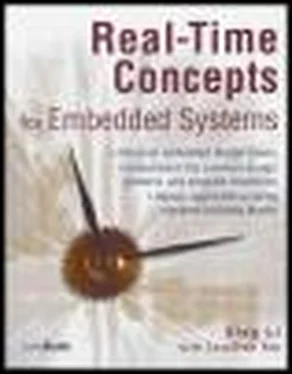The priority inversion shown in Figure 16.6 is a bounded priority inversion . The duration of the low-priority task's holding time on the shared resource is known. It is possible for a medium-priority task to preempt the low-priority task for an undetermined amount of time, which would cause the high-priority task to wait indefinitely. This priority inversion scenario is called unbounded priority inversion and is shown in Figure 16.7.
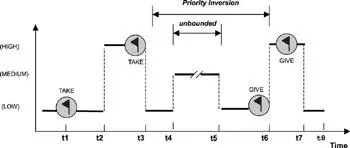
Figure 16.7: Unbounded priority inversion example.
As in the previous example, priority inversion takes place at time t3. The low-priority task (LP-task) executes until time t4 when an unrelated medium-priority task (MP-task) preempts it. Because the MP-task does not share resources with either the HP-task or the LP-task, the MP-task continues execution until it completes at time t5. The duration between t4 and t5 is unknown because the duration depends on the nature of the MP-task. In addition, any number of unrelated medium-priority tasks can execute during this period. These unknown factors affect the interval and translate into unbounded priority inversion.
When priority inversion occurs, the execution times for some tasks are reduced, while others are elongated. In Figure 16.7, consider the case in which the high-priority task (HP-task) takes the guarding semaphore before the low-priority task (LP-task). The medium-priority task (MP-task) must wait until the HP-task completes. However, when the MP-task executes first, it is preempted by the HP-task. Again, the MP-task resumes execution after the HP-task completes. In both cases, the overall execution times for the MP-task are longer than the execution time to complete the MP-task during the priority inversion. Although some tasks are completed early, other tasks, such as the HP-task, might miss their deadlines. This issue is called timing anomaly introduced by priority inversion.
Priority inversion results from resource synchronization among tasks of differing priorities. Priority inversion cannot be avoided, but it can be minimized using resource access control protocols.
A resource access control protocol is a set of rules that defines the conditions under which a resource can be granted to a requesting task and governs the execution scheduling property of the task holding the resource.
Access control protocols are discussed in the following sections. These access control protocols eliminate the unbound priority inversion, and two of these protocols reduce the inversion time.
16.4.1 Priority Inheritance Protocol
The Priority Inheritance Protocol is a resource access control protocol that raises the priority of a task, if that task holds a resource being requested by a higher priority task, to the same priority level as the higher priority task. This access control protocol follows the rules in Table 16.1 when a task T requests a resource R.
Table 16.1: Priority Inheritance Protocol rules.
| Rule # |
Description |
| 1 |
If R is in use, T is blocked. |
| 2 |
If R is free, R is allocated to T. |
| 3 |
When a task of a higher priority requests the same resource, T's execution priority is raised to the requesting task's priority level. |
| 4 |
The task returns to its previous priority when it releases R. |
This access control protocol is shown in Figure 16.8.
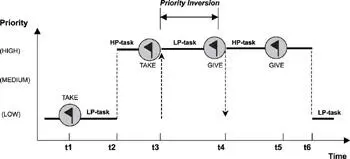
Figure 16.8: Priority inheritance protocol example.
With the priority inheritance protocol, when the LP-task blocks the HP-task at time t3, the execution priority is raised to that of the HP-task. This process ensures that unrelated medium-priority tasks cannot interfere while the LP-task executes, which results in the elimination of the unbounded priority inversion. When the LP-task releases control of the shared resource, the priority is immediately lowered to its previous level, which allows the HP-task to preempt its execution. This action ends the priority inversion at time t4. The HP-task continues its execution, however, even when it releases the resource at t5. This is the nature of the priority-based, preemptive scheduling scheme. The HP-task runs because it has the highest priority in the system.
The priority inheritance protocol is dynamic because a task does not have its priority raised until a higher-priority task makes a request on the shared resource. An unrelated higher-priority task can still preempt the task, which is the nature of the priority-based, preemptive scheduling scheme. The priority promotion for a task during priority inversion is transitive, which means the priority of a promoted task continues to rise even if higher-priority tasks make requests on the same shared resource while priority inversion is taking place, as shown in Figure 16.9.
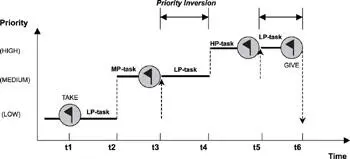
Figure 16.9: Transitive priority promotion example.
In this example, three tasks with differing priorities share a resource. The LP-task acquires the resource first at time t1. At time t2, the MP-task preempts the LP-task and executes until t3 when it needs the resource. The MP-task is blocked. At that point, the LP-task inherits the priority from the MP-task and resumes execution at that level. The HP-task preempts the LP-task when it readies at t4. The HP-task is blocked at t5 when it also needs access to the shared resource. Once more, the LP-task inherits its priority from HP-task and resumes execution at the highest level. As soon as the LP-task completes at time t6, its priority is immediately lowered to the level originally assigned.
In this example, the MP-task can hold some additional resource required by the HP-task. The HP-task can also acquire some other resources needed by the MP-task before the HP-task blocks. When the LP-task releases the resource and the HP-task immediately gets to run, it is deadlocked with the MP-task. Therefore, priority inheritance protocol does not eliminate deadlock.
16.4.2 Ceiling Priority Protocol
In the ceiling priority protocol, the priority of every task is known, as are the resources required by every task. For a given resource, the priority ceiling is the highest priority of all possible tasks that might require the resource.
For example, if a resource R is required by four tasks (T1 of priority 4, T2 of priority 9, T3 of priority 10, and T4 of priority 8), the priority ceiling of R is 10, which is the highest priority of the four tasks.
This access control protocol follows the rules in Table 16.2 when a task T requests a resource R.
Table 16.2: Ceiling priority protocol rules.
| Rule # |
Description |
| 1 |
If R is in use, T is blocked. |
| 2 |
If R is free, R is allocated to T. T's execution priority is raised to the priority ceiling of R if that is higher. At any given time, T's execution priority equals the highest priority ceiling of all its held resources. |
| 3 |
T's priority is assigned the next-highest priority ceiling of another resource when the resource with the highest priority ceiling is released. |
| 4 |
The task returns to its assigned priority after it has released all resources. |
This access control protocol is shown in Figure 16.10.
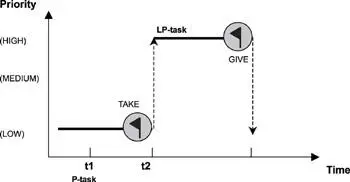
Figure 16.10: Ceiling priority protocol example.
Читать дальше
